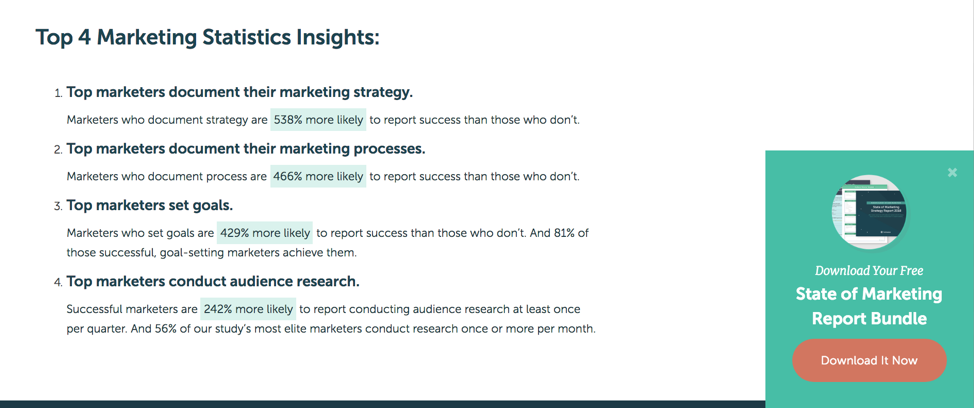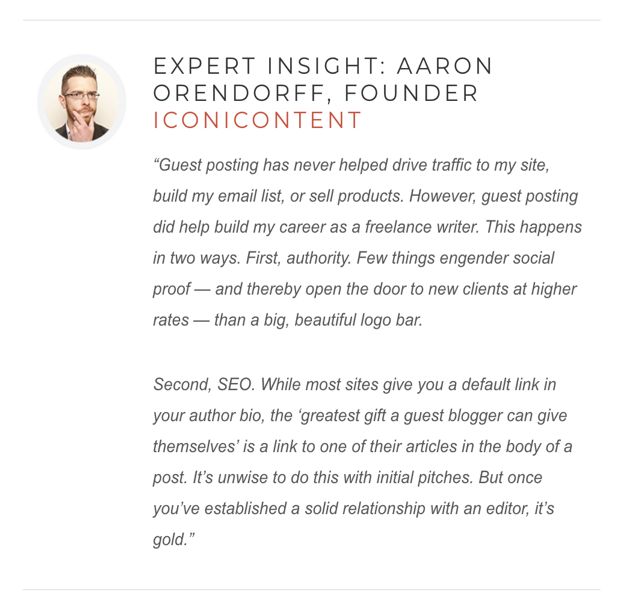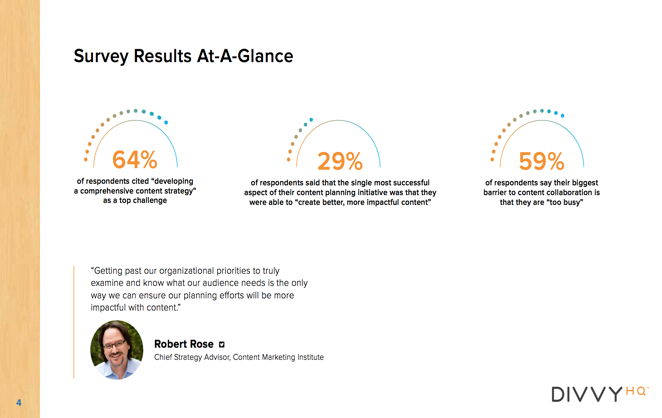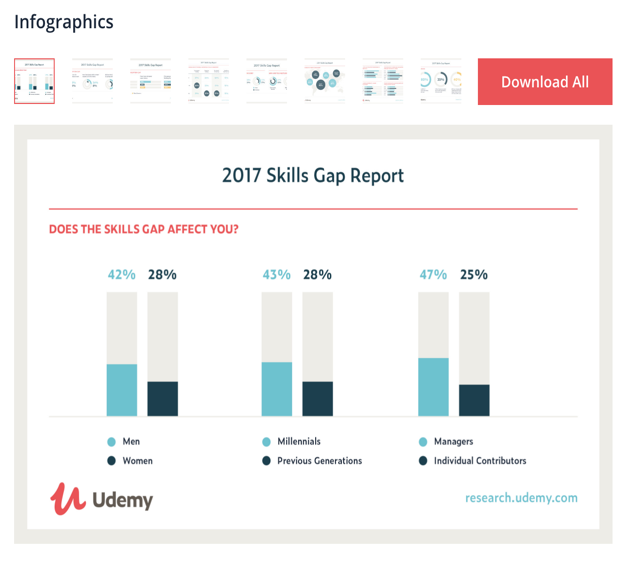Did you know Andy Crestodina spends 150 hours on his annual blogger study? (This truly blew my mind – and it’s just one of the many insights I gleaned from a recent podcast with Andy on the Inbound Success podcast on original research. Absolutely worth a listen!)
While I can’t quantify how much time I have invested on any given research project, it’s somewhere in the ballpark of heaps to a truckload. Putting in the time – and money – makes sense because research works, but you can do much more beyond publishing the initial findings.
#Research works & you can do much more beyond publishing the initial findings says @michelelinn.
Click To Tweet
To that end, I have studied how other marketers approach research and talked with those “in the trenches.” My goal is to learn from those who recently started publishing research as well as those who have been doing it awhile.
Today, I’m sharing a collection of solutions to missed opportunities that anybody doing their own original research can incorporate.
Have an ungated version of your research
The other week, I happened upon some strong research that had few shares or backlinks. When I dug in, I quickly realized the main research page was a gated form that teased the findings but offered little substance.
Of course, the company’s goal may be subscribers, but it’s tough to get many subscribers if people aren’t getting to your gated page.
It’s tough to get subscribers from your #research if people aren’t getting to the gated page. @michelelinn
Click To Tweet
I’ll let you in on a little secret, too: Some sites won’t link to gated pages because it feels promotional. Even if your research is fabulous, you may lose if you don’t have an open-access, useful page.
Don’t miss an opportunity to share your research findings wide and far, even if you are focused on leads. If you tell your story well in a blog post or article, people will want to read more – and they will be more apt to complete your form.
TIP: If your primary goals are brand awareness, traffic, or backlinks, forgo the gate altogether. And take advantage of this next opportunity …
Create a call to action for your research
Chances are, your research will uncover key challenges or things your audience isn’t doing but should be. Can you hear your readers practically screaming, “We need help!”?
Be proactive and figure out what content you can publish to help your readers with their biggest struggles – and use that as a call to action for your research.
For instance, the majority of Content Marketing Institute research is ungated. A key challenge was identified in that research and a gated guide was created on how to document a content marketing strategy. It’s been downloaded thousands of times.
Or, take this example from CoSchedule. Its State of Marketing report landing page uncovers key takeaways from the research – and the gated content bundles the report with documents and templates that align with these ideas: personas, a marketing plan, and a content plan.
Publish your research on SlideShare
This next idea comes from Hailley Griffis at Buffer, which recently published The State of Remote Work in 2018. When I asked what surprised her about the process – or what worked better than expected – she had one word: SlideShare.
Publish your #research on @SlideShare to generate more traffic, says @hailleymari.
Click To Tweet
She had not planned to put the research on the SlideShare platform, but it was an easy thing to try. She was surprised how much traffic it generated – more than 25,000 views as of this writing.
TIP: If you gate your research, you may be hesitant to release your research on SlideShare. However, most people don’t search for an ungated version if they come across a landing page with the gated version. (Do you?) Chances are different people will stumble across your research on SlideShare. If you aren’t certain, run a short experiment to see what happens.
Alternatively, if this SlideShare idea makes you or your management squeamish, create a skinny version for SlideShare that offers valuable information with a call to action to download the full version of your research.
At a minimum, create a skinny version of your #research study to post on #SlideShare, advises @michelelinn.
Click To Tweet
Highlight key stats in click-to-tweet format
When you write about your research, make it as easy as possible for people to share. CMI’s Blog and Community Operations Manager Lisa Dougherty adds Better Click to Tweet posts with key stats or insights in every article, but it works especially well in research articles.
Use @WordPress plugin Better Click to Tweet to make it easy to share #research stats via @brandlovellc.
Click To Tweet
Here is an example from CMI’s annual B2B content marketing research.
Include industry quotes
Another way to encourage social sharing – and add some color commentary to your research – is to include quotes from those in the industry.
One example to steal comes from Andy’s annual blogger study that takes the aforementioned 150 hours. For each survey finding, he shares a quote from an industry expert. Here is an example featuring Aaron Orendorff.
Or, check out how Brody Dorland of DivvyHQ incorporates quotes into its research, Content Planning Challenges, Trends & Opportunities. I like how a Twitter icon links to each person.
TIP: Sketch your key findings or sections to see how many quotes you need and match your quote to key takeaways when possible.
Proactively reach out to influencers
When I talk to people about research, I don’t hear often enough how they proactively reach influencers to talk about their research.
Of course, one way to make people aware of your research (and encourage them to share it) is to ask for quotes like Andy and Brody do. But, you want to cast a wider net.
Amanda Subler, CMI’s PR consultant, shared her approach and provides detailed templates you can use. The system is easy to understand and customize for your project.
Yes, it does take some time to reach out to influencers, but it’s worth it.
In fact, Priceonomics, a site that publishes a lot of original research, shared its process in the (lengthy but highly recommended) Content Marketing Handbook. One slightly mind-bending gem:
We tell people to start off by emailing 50+ journalists, because it conditions you to work very hard to spread your content after you write it … Another reason we tell people to email journalists after they publish a report is that we want you to anticipate what you’ll say to them before you are creating the content. What’s the hook going to be? How will you pitch it to someone? Why will it be interesting?
TIP: If you don’t know the journalists and influencers in your space, a tool like BuzzSumo can help. Dig in to see who has covered your topic or similar research. (Or, if this is an annual report, understand who covered your previous findings.)
If you don’t know journalists & #influencers in your space, a tool like @buzzsumo can help. @michelelinn.
Click To Tweet
Develop a library of graphics to be easily shared and used
You likely have spent time refining the charts, graphs, and other data visualizations in your report. Why not get as much from them as possible? My business partner Clare McDermott recently shared some ideas for dataviz to incorporate into your marketing, including original research.
Once you have dataviz, use it. I love how Udemy has a library of mini infographics from one of its research reports. These data-based graphics can easily be shared on social and in blog posts. (And, if you scroll through them, you can quickly understand the story.)
TIP: Include a source line and link on your charts and graphics so people can easily learn more about your research. (I’m continually surprised by how often I see that a source line is missing.)
Write about your research on other platforms
Someone recently asked about my biggest mistake with research. That’s easy: not pitching articles about the findings to other publications.
Of course, it makes sense to cover your research on your blog as it can be a traffic magnet, but you also have an opportunity to get in front of new audiences if you tailor and pitch posts to other publications.
For instance, Andrea Fryrear recently covered her research, State of Agile Marketing 2018, on several blogs including CMI and Marketing Insider Group.
TIP: Identify an angle for each publication that is relevant and meaningful to that audience. A simple regurgitation of stats won’t cut it.
Pitch your #research to other publications. Find a relevant angle for each, advises @MicheleLinn.
Click To Tweet
Include your research in your email signature or out of office
This next idea comes to us from Heike Young at Salesforce – and it’s the quickest one to put into action. When I was (coincidentally) emailing Heike about research Salesforce published, I received this out-of-office message:
TIP: Email signatures are also a great place to add a link to a key piece of research as well.
Include a link to your #research in your out of office message via @YoungHeike. Read more >>
Click To Tweet
Make it easy for people to reach out to you
Your research is story-worthy, and you want people to write about it, interview you, etc. Right? I imagine you nodding your head, but how easy do you make it for people to contact you?
I love talking to people about their research projects (please add a comment below or reach out anytime if you are interested in chatting). And, it surprises me how difficult it can be to find the person responsible for the research. Journalists, bloggers, podcast hosts, and more may want to talk to you as well, but if you don’t make it easy, they may quickly move on.
I really like how Unbounce includes a list of their contributors for its Conversion Benchmark Report. Not only does this make it easy for people to reach out, but it acknowledges the smarts of the team who developed the report.
Over to you. What else can marketers do to spread their research far and wide? Add your ideas in the comments. (And, if you have published research, let me know. I’d love to check it out.)
Need data to inform your content marketing strategy, budget increase, or new tactical implementation. Check out CMI’s annual B2B and B2C research.
Want to learn more about making the most of your research? Catch Michele’s session at Content Marketing World 2018. Register today using code BLOG100 to save $100.
Cover image by Joseph Kalinowski/Content Marketing Institute
The post 10 (Mostly) Quick Wins to Steal for Your Original Research Project appeared first on Content Marketing Institute.
from Content Marketing Institute https://ift.tt/2HWgtAM









No comments:
Post a Comment